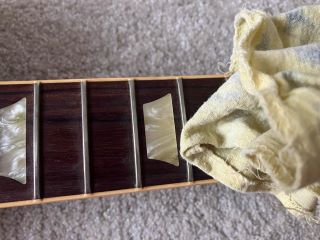CLEANING YOUR FRETBOARD
If you’ve read our post on prolonging string life, you’ll understand the benefits of keeping your strings clean. So why live with a dirty fretboard?
Fretboards get dirty. Our hands transfer dirt, sweat and oils onto the strings and onto the wood and frets beneath them. Take a look at your own fretboard under good light to see how much dirt has accumulated in the most frequently-used areas of the fretboard, particularly up against the frets.
You can keep your fretboard cleaner for longer by washing your hands before playing, keeping your strings clean and storing your guitar in its case or gig bag. But sooner or later your fretboard will need some attention.
How often should I clean my fretboard?
We recommend that you clean your fretboard each time you change strings. To do a good job you need unrestricted access so the strings really need to be removed first.
If you clean your fretboard regularly, wiping it with a lightly dampened cloth should be enough to remove any accumulated dirt, sweat or oils. Give it a once over with a dry cloth afterwards to soak up any residual moisture.

Oils and fretboard cleaners
Oils like lemon oil (formulated for guitar; not pure lemon oil) and boiled linseed oil do a good job of dislodging dirt which can then be wiped away. Try this if a damp cloth alone is not enough. Dampen a clean cloth with a little bit of oil and rub onto the fretboard. Keep a bunch of strips of old t-shirt available for this purpose.
Many manufacturers offer fretboard cleaning products specifically developed for guitars and other stringed instruments. Simply apply them to a clean cloth and then wipe the fretboard. D’addario’s Hydrate, Dunlop 65 Fingerboard Cleaner and Dr Duck’s Ax Wax* are all good choices. Make sure cleaning products are silicone-free.
Many guitar techs use naphtha (basically, lighter fluid) to clean fretboards. It works well but certainly isn’t a necessity. If you try it, make sure you do so in a well-ventilated area and avoid breathing in the fumes for longer than necessary. Naphtha won’t attack glue that might be holding binding, inlay or frets to the fretboard. Some solvents can, and can also damage your guitar’s finish – so avoid them.
Wire wool
Running wire wool (only ever use 0000-grade ultra-fine wool) up and down the length of the fretboard (including over the frets) will remove accumulated grime. It will also polish the wood surface and shine your frets nicely. No additional cleaning product is necessary.
The disadvantage of wire wool is that it sheds tiny particles of steel. These particles can stick to your guitar’s pickups (which are magnets) and scratch your guitar’s finish if you don’t clean up well enough. Many players make a point of avoiding wire wool for these reasons.
If you do choose to use wire wool, first read our guidelines for using wire wool to clean a fretboard.

Toothbrush
Use a soft-bristled toothbrush, or save an old used toothbrush, and use this with a bit of lemon or linseed oil to gently brush stubborn dirt out of the wood. Toothbrush bristles are ideal for getting grime out of hard-to-reach areas like cracks in the wood or where the frets meet the fretboard. When the dirt is dislodged, wipe the fretboard down with a damp cloth.
If your soft bristles are too soft you can experiment with trimming them a little shorter, which creates a bit more resistance. Don’t use bristles that are too strong because they can scratch the fretboard.

Razor blade
It is possible to scrape particularly thick or stubborn dirt off using a razor blade. Keep the blade at a 90-degree angle to the fretboard and slide the blade over the surface of the fretboard. Don’t press on or dig into the wood. There is an art to this, so if it’s not something you’ve done before it’s probably a method to avoid. If you do try it remember (at the risk of stating the obvious) that razor blades are extremely sharp. Be very careful not to damage the guitar or yourself.
What about finished fretboards?
Lighter-coloured fretboards, such the those made from maple, are often coated (or ‘finished’) with a thin layer of protective lacquer. These fretboards are easy to clean. A damp cloth is all that’s required to remove any dirt. Do not use oils, wire wool, toothbrushes or razor blades on a finished fretboard. They will damage the lacquer. Only use a cleaning product if you’re sure it’s safe to use with the finish on your fretboard.

The methods described here can be used alone or in combination. Each brand and manufacturer has its own advice on how to clean a fretboard and what tools and products to use. Find the methods and products that work for you, and which are compatible with your instrument.
How do you clean your fretboard?
Join us on Facebook
* This is an affiliate link. If you purchase through this link we make a very small commission. You don’t pay any extra for the product.
DIRTY FRETBOARD?
Our fretboard care package includes a fretboard clean including getting all that grime out from under the frets,
conditioning (not finished maple fretboards) and a full fret polish (including buffing). We’ll even re-string for free.
See our list of services to find out what else we have to offer.
